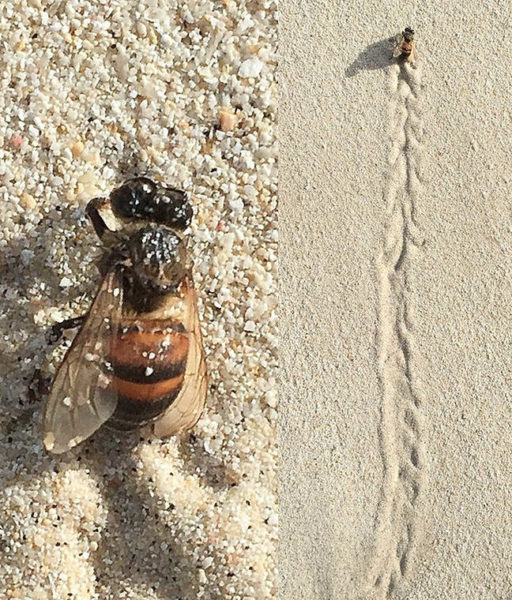Published in the Ocean Watch column, Honolulu Star-Advertiser © Susan Scott
February 15, 2020
The emails I get from readers of this column are mostly about marine animals, but one terrestrial creature comes up surprisingly often: bees. Why, people ask, do we see so many honey bees near the shoreline on windward beaches? One reader last week thought the bee she saw was digging.
Struggling in the sand near breaking waves is certainly not a honeybee’s choice. Those that can still walk might look like they’re digging, but the plowing motion of those six legs are more likely the bee’s death throes.
 A salt-sprayed honeybee got sand stuck to its body
A salt-sprayed honeybee got sand stuck to its body
and wings and left a staggering trail, right, at Kailua Beach.
©2020 Susan Scott
A honey bee’s daily life gives clues as to how these insects end up dying on our beaches and unintentionally stinging our feet.
The honeybees we see foraging for nectar are all nonreproductive females that have graduated from housekeeping.
After hatching, female worker bees do hive chores such as making wax and shaping it into honeycomb. In hot weather, house bees fan the interior with their wings to keep the wax from melting. House bees also clean and repair the hive, act as guards against raiders and feed the queen, larva and males.
Honeybee males, called drones, don’t lift a wing to help out. Their one job is to wait for their turn to mate with the queen and then die.
When a house worker is 2 to 3 weeks old, she leaves the hive to find nectar, pollen and fresh water. During searches, worker bees fly erratic routes. Once loaded up, though, they take the most direct route — a beeline — back to the hive.
If that route crosses a bay, wind and breaking waves can deposit salt spray on a low-flying bee’s wings and bring down the bee. Onshore winds push the crashed creatures to the beach where they soon die.
Another possibility for beached bees is that they’ve reached the end of their natural life span while flying over a bay or near a beach. The life span of a worker bee is six weeks in summer and up to six months in winter.
Dying bees can still stick their sharp stingers into our (or our dog’s) feet. Two pairs of the bee’s muscles push the stinger in deep while other muscles pump venom into the wound.
Because it takes about two minutes for a honeybee’s venom sac to empty completely, get the stinger out fast. Pinch it with your fingers and pull. If you’re not allergic, removing the stinger is the only treatment that matters.